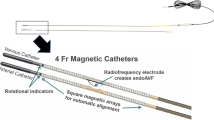Abstract
The current study retrospectively evaluated whether endovascular revascularization of chronically thrombosed and long-discarded vascular access sites for hemodialysis was feasible. Technical and clinical success rates, postintervention primary and secondary patency rates, and complications were reported. During a 1-year period, we reviewed a total of 924 interventions performed for dysfunction and/or failed hemodialysis vascular access sites and permanent catheters in 881 patients. In patients whose vascular access-site problems were considered untreatable or were considered treatable with a high risk of failure and access-site abandonment, we attempted to revascularize (resurrect) the chronically occluded and long-discarded (mummy) vascular access sites. We attempted to resurrect a total of 18 mummy access sites (mean age 46.6 ± 38.7 months; range 5–144) in 15 patients (8 women and 7 men; mean age 66.2 ± 11.5 years; age range 50–85) and had an overall technical success rate of 77.8%. Resurrection failure occurred in 3 fistulas and in 1 straight graft. The clinical success rate was 100% at 2 months after resurrection. In the 14 resurrected vascular access sites, 6 balloon-assisted maturation procedures were required in 5 fistulas; after access-site maturation, a total of 22 interventions were performed to maintain access-site patency. The mean go-through time for successful resurrection procedures was 146.6 ± 34.3 min (range 74–193). Postmaturation primary patency rates were 71.4 ± 12.1% at 30 days, 57.1 ± 13.2% at 60 days, 28.6 ± 13.4% at 90 days, and 19 ± 11.8% at 180 days. Postmaturation secondary patency rates were 100% at 30, 60, and 90 days and 81.8 ± 11.6% at 180 days. There were 2 major complications consisting of massive venous ruptures in 2 mummy access sites during balloon dilation; in both cases, prolonged balloon inflation failed to achieve hemostasis, but percutaneous N-butyl cyanoacrylate glue seal-off was performed successfully. Percutaneous resurrection of mummy vascular access sites for hemodialysis is technically feasible with high clinical success rates. In selected patients, resurrection of mummy access sites provides long-discarded access sites one more chance to be used for hemodialysis in an effort to preserve potential extremity sites for future access-site placement and to prevent long-term catheter indwelling.



Similar content being viewed by others
References
NKF-K/DOQI clinical practice guidelines for vascular access: updates 2006. Available at: http://www.kidney.org/professionals/KDOQI/guideline_upHD_PD_VA/va_guide2.htm. Accessed 15 Oct 2009
Rajan DK, Clark TW, Simons ME, Kachura JR, Sniderman K (2002) Procedural success and patency after percutaneous treatment of thrombosed autogenous arteriovenous dialysis fistulas. J Vasc Interv Radiol 13:1211–1218
Beathard GA (2006) Successful treatment of the chronically thrombosed dialysis access graft: Resuscitation of dead grafts. Semin Dial 19:417–420
Jaffe R, Leung G, Munce NR, Thind AS, Leong-Poi H, Anderson KJ et al (2009) Natural history of experimental arterial chronic total occlusions. J Am Coll Cardiol 53:1148–1158
Sacks D, Marinelli DL, Martin LG, Spies JB (2003) Reporting standards for clinical evaluation of new peripheral arterial revascularization devices. J Vasc Interv Radiol 14(Suppl 9 Pt 2):S395–S404
Liang HL, Pan HB, Chung HM, Ger LP, Fang HC, Wu TH et al (2002) Restoration of thrombosed Brescia-Cimino dialysis fistulas by using percutaneous transluminal angioplasty. Radiology 223:339–344
Turmel-Rodrigues L, Pengloan J, Rodrigue H, Brillet G, Lataste A, Pierre D et al (2000) Treatment of failed native arteriovenous fistulae for hemodialysis by interventional radiology. Kidney Int 57:1124–1140
Vorwerk D, Bucker A, Alzen G, Schurmann K, Ritzerfeld M, Gunther RW (1995) Chronic venous occlusions in haemodialysis shunts: efficacy of percutaneous treatment. Nephrol Dial Transplant 10:1869–1873
Turmel-Rodrigues L, Sapoval M, Pengloan J, Billaux L, Testou D, Hauss S et al (1997) Manual thromboaspiration and dilation of thrombosed dialysis access: mid-term results of a simple concept. J Vasc Interv Radiol 8:813–824
Gupta H, Murphy TP, Soares GM (1998) Use of a puncture needle for recanalization of an occluded right subclavian vein. Cardiovasc Intervent Radiol 21:508–511
Honnef D, Wingen M, Gunther RW, Haage P (2005) Sharp central venous recanalization by means of a TIPS needle. Cardiovasc Intervent Radiol 28:673–676
Acknowledgements
The authors thank Yi-Wen Wu, the executive secretary of the VAT, for assistance in providing clinical follow-up for this study.
Conflict of interest statement
The authors have no conflict of interests to disclose.
Author information
Authors and Affiliations
Corresponding author
Rights and permissions
About this article
Cite this article
Weng, MJ., Chen, M.CY., Chi, WC. et al. Endovascular Revascularization of Chronically Thrombosed Arteriovenous Fistulas and Grafts for Hemodialysis: A Retrospective Study in 15 Patients With 18 Access Sites. Cardiovasc Intervent Radiol 34, 319–330 (2011). https://doi.org/10.1007/s00270-010-9926-7
Received:
Accepted:
Published:
Issue Date:
DOI: https://doi.org/10.1007/s00270-010-9926-7




